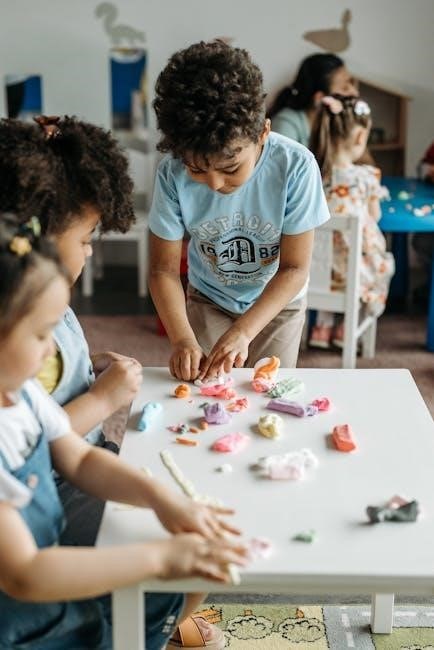Social-Emotional Learning (SEL) is a transformative approach in education, fostering essential life skills like self-awareness, empathy, and decision-making. Through engaging activities, SEL reduces anxiety, enhances collaboration, and promotes emotional growth, preparing students for lifelong success.
1.1 Definition and Importance of SEL
Social-Emotional Learning (SEL) is an educational approach that helps individuals develop essential life skills, such as self-awareness, empathy, and decision-making. It focuses on nurturing emotional intelligence to improve relationships, academic performance, and mental well-being. SEL is crucial as it equips students with tools to manage emotions, reduce anxiety, and collaborate effectively. By fostering a supportive environment, SEL prepares learners to navigate challenges and thrive in all aspects of life, making it a cornerstone of holistic education.
1.2 Benefits of SEL in Education
Social-Emotional Learning (SEL) significantly enhances students’ academic performance, classroom behavior, and mental well-being. By fostering emotional intelligence, SEL reduces anxiety and stress, improving focus and engagement. It cultivates collaboration, empathy, and conflict resolution skills, creating a supportive learning environment. SEL also promotes self-awareness and self-management, empowering students to make responsible decisions. These benefits extend beyond academics, preparing students for long-term success in relationships and future careers, making SEL a vital component of modern education.
1.3 Key Skills Developed Through SEL
Social-Emotional Learning (SEL) cultivates five core competencies: self-awareness, self-management, social awareness, relationship skills, and responsible decision-making. These skills enable students to understand their emotions, manage stress, and empathize with others. SEL fosters collaboration, communication, and conflict resolution, while promoting self-reflection and goal-setting. By developing these skills, students build strong relationships, make informed choices, and navigate challenges effectively, preparing them for personal and professional success in an ever-changing world.

Core Competencies of Social-Emotional Learning
Social-Emotional Learning (SEL) is built on five core competencies: self-awareness, self-management, social awareness, relationship skills, and responsible decision-making. These competencies help students understand and manage emotions, fostering collaboration, empathy, and personal growth through structured activities.
2.1 Self-Awareness Activities
Self-awareness activities help students recognize and understand their emotions, values, and strengths. These activities include identifying emotions through feelings charts, creating emotional journals, and engaging in mindfulness exercises. Students learn to reflect on their thoughts and behaviors, fostering self-reflection. Activities like “Emotional ID” and “I-Spy” encourage students to communicate their feelings effectively. These exercises promote personal growth, enabling students to manage emotions and make informed decisions, while also enhancing their ability to understand themselves and their place in social contexts.
2.2 Self-Management Skills
Self-management skills empower students to regulate emotions, behaviors, and thoughts. Activities include mindfulness exercises, deep-breathing techniques, and reflection journals. Students practice impulse control through structured games and role-playing. Mindfulness helps them stay calm and focused, while reflection journals encourage self-assessment. These tools teach self-discipline, stress management, and problem-solving, fostering better decision-making and emotional resilience. By mastering self-management, students improve their ability to handle challenges and maintain positive behaviors in various situations, both academically and socially.
2.3 Social Awareness and Empathy
Social awareness and empathy involve understanding others’ perspectives and emotions. Activities like role-playing, group discussions, and kindness exercises foster these skills. Students engage in games such as “I-Spy” to recognize emotions and “Acts of Kindness” to practice compassion. Reflection tools like journals and visual representations encourage deeper understanding of social dynamics. These exercises help students develop empathy, communicate effectively, and build inclusive relationships, equipping them to navigate diverse social situations with sensitivity and respect.
2.4 Relationship Skills
Relationship skills are vital for building strong, positive connections with others. Activities like role-playing, group discussions, and cooperative games help students practice communication, active listening, and conflict resolution. These exercises encourage empathy, mutual respect, and teamwork. For example, students can engage in group projects that require collaboration, fostering trust and understanding. Role-playing scenarios also help students navigate social challenges, such as resolving disagreements or expressing needs clearly. These activities empower students to form healthy, supportive relationships in all areas of life.
2.5 Responsible Decision-Making
Responsible decision-making involves analyzing situations, weighing options, and choosing ethical actions. Activities like task cards with social scenarios and problem-solving exercises help students practice this skill. These exercises guide students to consider consequences, think critically, and make informed choices. By engaging in real-world applications, students develop the ability to navigate challenges thoughtfully and contribute positively to their communities. These activities foster a sense of accountability and prepare students to make wise decisions in all areas of life.

SEL Activities for the Classroom
Classroom SEL activities include group collaborations, emotional intelligence games, and mindfulness exercises. These practices foster teamwork, self-regulation, and empathy, creating a supportive learning environment for all students.
3.1 Group Activities to Enhance Collaboration
Group activities are a cornerstone of SEL, fostering teamwork and mutual respect. Examples include collaborative problem-solving tasks, role-playing exercises, and shared creative projects. These activities encourage students to communicate effectively, listen actively, and value diverse perspectives. By working together, students build trust and develop essential relationship skills. Structured group challenges, such as building models or solving puzzles, also enhance problem-solving abilities. These collaborative experiences not only strengthen social bonds but also create a supportive classroom environment, preparing students to thrive in real-world teamwork scenarios.
3.2 Emotional Intelligence Games
Emotional intelligence games are engaging tools that help students recognize, understand, and manage emotions. Activities like “Feelings Charades” and “Emotion Matching Games” encourage students to identify and express emotions. Games such as “Empathy Role-Playing” and “Mood Meters” further enhance self-awareness and empathy. These interactive exercises foster a deeper understanding of emotions, helping students navigate social situations effectively. By incorporating fun and relatable scenarios, these games make emotional learning accessible and enjoyable, promoting emotional growth and stronger interpersonal connections in the classroom and beyond.
3.3 Role-Playing Exercises for Conflict Resolution
Role-playing exercises are effective tools for teaching conflict resolution skills. Students act out real-life scenarios, such as disagreements or misunderstandings, to practice resolving conflicts peacefully. Activities like “Disgusting Team Sandwich” or “Marshmallow Challenge” encourage collaboration and problem-solving. These exercises help students understand different perspectives, communicate effectively, and develop empathy. By simulating conflicts, students learn to navigate challenging situations calmly and constructively, fostering a more harmonious classroom environment and preparing them for real-world interactions.
3.4 Mindfulness and Stress Reduction Techniques
Mindfulness and stress reduction techniques are vital for fostering emotional well-being in students. Activities like deep breathing exercises, guided meditation, and mindful coloring help students calm their minds and manage stress. These practices teach self-regulation, improving focus and emotional resilience. By incorporating mindfulness into daily routines, educators create a supportive environment where students can thrive academically and socially, reducing anxiety and promoting overall well-being. Regular mindfulness practices also enhance self-awareness, a key component of social-emotional learning.

SEL Activities for Home and Family
Engage families with activities like sharing toys, collaborative play, and emotional discussions. Parents can foster empathy and kindness through daily interactions, promoting social-emotional growth in a nurturing environment.
4.1 Parent-Child SEL Games
Engage your child with fun SEL games like sharing toys, collaborative building, and emotional charades. These activities foster empathy, self-control, and communication skills. Encourage open conversations about feelings and kindness during play. Simple games like “Feeling Bottles” or role-playing scenarios help children express emotions and understand others’ perspectives. Parent-child interactions during these games strengthen bonds and promote emotional intelligence, creating a supportive environment for social-emotional growth. These activities are easy to integrate into daily routines, making SEL accessible and enjoyable for the whole family.
4.2 Teaching Empathy Through Daily Interactions
Model empathetic behavior by sharing feelings and perspectives during daily routines. Discuss emotions openly, encouraging your child to recognize and articulate their feelings. Use teachable moments, like witnessing someone’s sadness, to explore empathy. Engage in activities like role-playing or sharing stories to foster understanding. Encourage kindness through small acts, such as helping others or donating toys. These interactions create opportunities for children to develop compassion and connect with others’ experiences, laying a strong foundation for empathy.
4.3 Encouraging Kindness and Sharing
Encourage kindness and sharing by modeling positive behaviors and providing opportunities for collaborative play. Activities like sharing toys, building with blocks, or playing dress-up foster generosity and cooperation. Discuss the importance of kindness during daily interactions, highlighting how small acts, like helping others, can make a difference. Praise children when they exhibit sharing behaviors, reinforcing the value of kindness. These practices help develop empathy and social skills, creating a strong foundation for positive relationships and a compassionate mindset.
4.4 Family Discussions on Emotions and Values
Family discussions on emotions and values create a safe space for children to express feelings and understand their significance. These conversations help kids recognize, label, and manage emotions while connecting them to family values. Regular talks foster empathy, kindness, and a strong moral compass. By sharing experiences and perspectives, families build trust and openness, teaching children to align their actions with positive values. Such discussions empower children to navigate emotional challenges and develop a resilient, value-driven mindset.
SEL Worksheets and Printable Resources
Social-emotional learning worksheets and printable resources offer structured exercises for self-reflection, goal setting, and emotional awareness. These tools include task cards, feeling identification activities, and visual expression prompts.
5.1 Worksheets for Self-Reflection and Goal Setting
Worksheets for self-reflection and goal setting are essential tools in SEL, helping students identify emotions, set SMART goals, and track progress. Activities include emotional check-ins, gratitude journals, and self-assessment checklists. These resources guide students in understanding their strengths, challenges, and personal growth areas. For example, worksheets like “Introvert or Extrovert” and “Optimist or Pessimist” encourage students to explore their traits and attitudes. These exercises foster emotional intelligence, self-awareness, and accountability, empowering students to take control of their personal development.
5.2 Emotional Awareness and Identification Exercises
Emotional awareness and identification exercises help students recognize, understand, and label their emotions. Activities like “Emotion Charades” and “Feeling Bottles” encourage children to express and identify emotions. Worksheets such as “Emotional ID” and “Understanding Feelings” guide students in connecting emotions to situations. These exercises enhance self-awareness, allowing students to articulate their feelings effectively. Visual representations, like mood charts, further support emotional recognition, helping students navigate their emotional experiences and respond appropriately in real-life situations.
5.3 Social Scenarios for Discussion and Problem-Solving
Social scenarios for discussion and problem-solving encourage students to explore real-life situations, fostering critical thinking and empathy. Activities like “Disgusting Team Sandwich” and role-playing exercises help students navigate conflicts and collaboration. Task cards with social dilemmas prompt discussions on kindness, sharing, and decision-making. These exercises enhance relationship skills, teaching students to communicate effectively and resolve disagreements constructively. By engaging in these activities, students develop the ability to approach social challenges with confidence and understanding.
5.4 SEL Activity Planners for Teachers and Parents
SEL activity planners offer structured resources for educators and caregivers to integrate social-emotional learning into daily routines. These planners include flexible lesson ideas, such as group activities, emotional intelligence games, and mindfulness exercises. They provide tools to design engaging, age-appropriate experiences that foster collaboration, empathy, and self-awareness. By using these planners, teachers and parents can create meaningful learning opportunities, ensuring consistent SEL practice in both classrooms and homes. These resources empower adults to support children’s emotional and social growth effectively and creatively.

SEL Games and Interactive Activities
Engaging SEL games and interactive activities, such as board games, digital tools, and outdoor exercises, promote teamwork, emotional expression, and problem-solving. These activities foster collaboration and creativity, making learning fun and impactful for students of all ages.
6.1 Board Games for Social Skills Development
Board games are excellent tools for fostering social skills in students. Games like “Acts of Kindness” and “Alpha and Omega” encourage empathy, cooperation, and conflict resolution. “Disgusting Team Sandwich” promotes teamwork and communication, while “Emotional ID” helps students recognize and manage emotions. These activities create a fun, interactive environment where students can practice essential social skills, develop emotional intelligence, and build stronger relationships with peers. Such games are adaptable to various age groups and learning settings, making them a versatile resource for SEL development.
6.2 Digital Tools and Apps for SEL
Digital tools and apps are revolutionizing SEL by offering interactive and engaging activities. Minecraft Education inspires emotional intelligence and social awareness through creative building tasks. Apps provide exercises like emotion identification and scenario-based problem-solving. Digital platforms also offer SEL activity planners and reflection worksheets. These tools enhance engagement, making learning accessible and fun for students. They cater to various learning styles, especially visual and hands-on learners, fostering a deeper understanding of social-emotional concepts in an innovative way.
6.3 Outdoor Activities Promoting Teamwork
Outdoor activities are a powerful way to foster teamwork and social-emotional learning. Games like capture the flag, group obstacle courses, and collaborative sports encourage communication, trust, and problem-solving. These activities help students develop relationship skills and social awareness while promoting physical health. Outdoor settings often create a more relaxed environment, making it easier for students to connect and work together. By engaging in these shared experiences, students build stronger bonds and learn to rely on one another, enhancing their ability to collaborate effectively in all areas of life.
6.4 Creative Arts Projects for Emotional Expression
Creative arts projects offer a powerful medium for students to express and explore their emotions. Activities such as painting, drawing, or crafting allow individuals to convey feelings non-verbally, fostering self-awareness and emotional intelligence. Group art projects encourage collaboration and empathy, as students share perspectives and work together to create meaningful pieces. These activities not only enhance creativity but also provide a safe space for students to process and communicate their emotions, promoting personal growth and social-emotional development in a fun and engaging manner.

SEL for Different Age Groups
Social-Emotional Learning is tailored for various age groups, ensuring activities meet developmental needs. From early childhood to college, SEL fosters emotional growth, empathy, and life skills.
7.1 Activities for Early Childhood (Pre-K to Grade 2)
For early childhood, SEL activities focus on play-based learning, such as sharing toys, role-playing, and group games. These interactions help develop social skills, emotional awareness, and empathy. Activities like building with blocks, coloring, and dress-up encourage collaboration and self-expression. Teaching children to identify and communicate emotions through simple exercises, like feeling charts or storytelling, fosters self-awareness. Playdates and group tasks promote teamwork and kindness, laying a strong foundation for future social-emotional growth.
7.2 SEL Strategies for Middle School Students
SEL strategies for middle school focus on fostering social awareness, empathy, and decision-making skills. Activities include group discussions on social scenarios, role-playing for conflict resolution, and reflection journals. These exercises help students navigate peer relationships and emotional challenges during adolescence. Teachers also incorporate mindfulness techniques and team-building exercises to enhance collaboration and self-management. By addressing real-life issues, SEL empowers middle school students to develop resilience, communication skills, and a stronger sense of responsibility, preparing them for high school and beyond.
7.3 High School SEL Programs and Workshops
High school SEL programs focus on advanced social-emotional skills, such as stress management, relationship building, and decision-making. Workshops often incorporate peer discussions, role-playing, and reflective journaling to address real-life challenges. Mindfulness exercises and team-building activities help students develop self-awareness and empathy. These programs also emphasize preparing students for post-graduation by fostering independence, self-advocacy, and career readiness. By integrating SEL into high school curricula, educators help students navigate complex social dynamics and build resilience for future success.
7.4 SEL for College Students and Young Adults
SEL for college students and young adults focuses on fostering independence, resilience, and emotional intelligence. Activities include mindfulness exercises, stress management workshops, and career readiness programs. These initiatives help students navigate transitions, build healthy relationships, and develop self-advocacy skills. By addressing challenges like time management and self-care, SEL supports young adults in achieving academic and personal success. These programs also emphasize emotional awareness and decision-making, equipping individuals with lifelong skills for thriving in an ever-changing world.

Measuring the Impact of SEL Activities
Assessing progress, using feedback, and researching effectiveness ensure SEL programs drive positive outcomes, fostering emotional growth and skill development in students of all ages effectively.
8.1 Assessing Student Progress in SEL
Assessing student progress in SEL involves monitoring growth in self-awareness, empathy, and decision-making through structured tools and observations. Worksheets, task cards, and reflective activities help evaluate emotional intelligence and social skills. Teachers and parents use these resources to track improvements in behavior and problem-solving abilities, ensuring tailored support for each student’s development. Regular feedback and progress tracking are essential for understanding the effectiveness of SEL activities and guiding future interventions. This ongoing assessment ensures students build strong emotional and social foundations for long-term success.
8.2 Using Feedback to Improve SEL Programs
Feedback is crucial for refining SEL programs, ensuring they meet students’ needs. Teachers and parents collect input through surveys, observations, and student reflections, identifying strengths and areas for improvement. This data helps adjust activities, enhance engagement, and address specific challenges. By incorporating feedback, SEL programs become more effective, fostering better social-emotional growth. Continuous improvement ensures programs remain relevant and impactful, supporting students’ emotional and social development in a tailored and responsive manner.
8.3 Research on the Effectiveness of SEL
Research consistently highlights the positive impact of SEL on students’ emotional and academic outcomes. Studies show improved emotional regulation, empathy, and academic performance. SEL activities reduce behavioral issues and enhance mental health. Long-term benefits include better life outcomes, such as stronger relationships and career success. Evidence underscores SEL’s role in fostering resilience and preparing students for future challenges, making it a vital component of holistic education.
8.4 Long-Term Benefits of SEL Implementation
Implementing SEL fosters long-term benefits, including improved emotional regulation, mental health, and interpersonal relationships. Students develop resilience, enabling them to navigate life challenges effectively. SEL equips individuals with skills that enhance career success, personal growth, and community engagement. Research indicates that these benefits persist into adulthood, contributing to stronger, more empathetic societies. The enduring impact of SEL underscores its importance in shaping well-rounded, capable individuals prepared for future endeavors.
Overcoming Challenges in SEL Implementation
Addressing SEL challenges involves training educators, engaging parents, and ensuring equity. Effective communication and adaptable strategies help overcome controversies, fostering inclusive and impactful SEL programs.
9.1 Addressing Controversies Surrounding SEL
SEL implementation often faces criticism, with debates centering on curriculum content and perceived indoctrination. Addressing these controversies requires open dialogue, educator training, and parental involvement. Clear communication about SEL’s focus on emotional growth and life skills helps dispel misconceptions. Ensuring programs are evidence-based and inclusive fosters trust. Collaboration between schools and communities is key to resolving conflicts and promoting SEL’s benefits effectively.
9.2 Ensuring Equity and Inclusivity in SEL
Ensuring equity and inclusivity in SEL requires intentional strategies to meet diverse student needs. Culturally responsive practices and inclusive resources help create safe spaces for all learners. By addressing implicit biases and promoting diverse perspectives, SEL fosters empathy and understanding. Schools must provide professional development for educators to implement equitable SEL practices effectively. This ensures every student, regardless of background, can benefit from social-emotional growth and develop essential life skills in an inclusive environment;
9.3 Engaging Parents and Caregivers in SEL
Engaging parents and caregivers in SEL is crucial for consistent emotional growth. Schools can share SEL resources and activities, fostering collaboration between home and classroom. Encouraging open communication and involving parents in workshops or family discussions promotes shared goals. Providing practical strategies, such as empathy-building games and emotional awareness exercises, empowers caregivers to support SEL at home, ensuring a cohesive approach to student development.
9.4 Training Educators to Teach SEL Effectively
Training educators to teach SEL effectively involves providing professional development opportunities, such as workshops and online courses. These programs focus on integrating SEL into curricula, using evidence-based activities, and fostering supportive classroom environments. Educators learn strategies to model SEL skills, create engaging activities, and assess student progress. Continuous support and resources, like SEL activity guides, empower teachers to confidently implement SEL, ensuring students develop essential life skills. Ongoing training ensures educators stay updated on best practices, enhancing their ability to promote social-emotional growth.
Social-Emotional Learning (SEL) is vital for fostering well-rounded development, reducing anxiety, and promoting collaboration. As its importance grows, innovations in SEL activities and resources will expand its reach, ensuring students thrive emotionally and academically.
10.1 The Growing Importance of SEL
Social-Emotional Learning (SEL) is increasingly recognized as essential for student development, fostering skills like self-awareness, empathy, and responsible decision-making; As education evolves, SEL addresses contemporary challenges, such as mental health and social dynamics, preparing students for future successes. Its integration into classrooms and homes highlights its expanding role in holistic education, ensuring learners thrive emotionally and academically. The growing emphasis on SEL underscores its potential to create a more compassionate and resilient society.
10.2 Innovations in SEL Activities and Resources
Innovations in SEL activities and resources are revolutionizing how students develop emotional and social skills. Digital tools, interactive games, and creative worksheets are making SEL more engaging and accessible. Resources like Minecraft Education and social scenario task cards are being used to foster empathy and collaboration. Additionally, printable PDFs and online platforms offer tailored activities for different age groups, from early childhood to high school. These advancements ensure SEL is adaptive, fun, and inclusive, catering to diverse learning needs and fostering a culture of emotional intelligence and social awareness.
10.3 Expanding SEL Beyond the Classroom
Expanding SEL beyond the classroom involves engaging families and communities in fostering emotional and social growth. Parents can use SEL activities like sharing games, empathy exercises, and family discussions to reinforce learning at home. Communities can integrate SEL into extracurricular programs, ensuring a holistic approach. Schools are also leveraging digital tools and printable resources to involve caregivers, creating a seamless transition between classroom and home. This collaborative effort ensures SEL becomes a lifelong skill, preparing individuals for future challenges and fostering a supportive society.